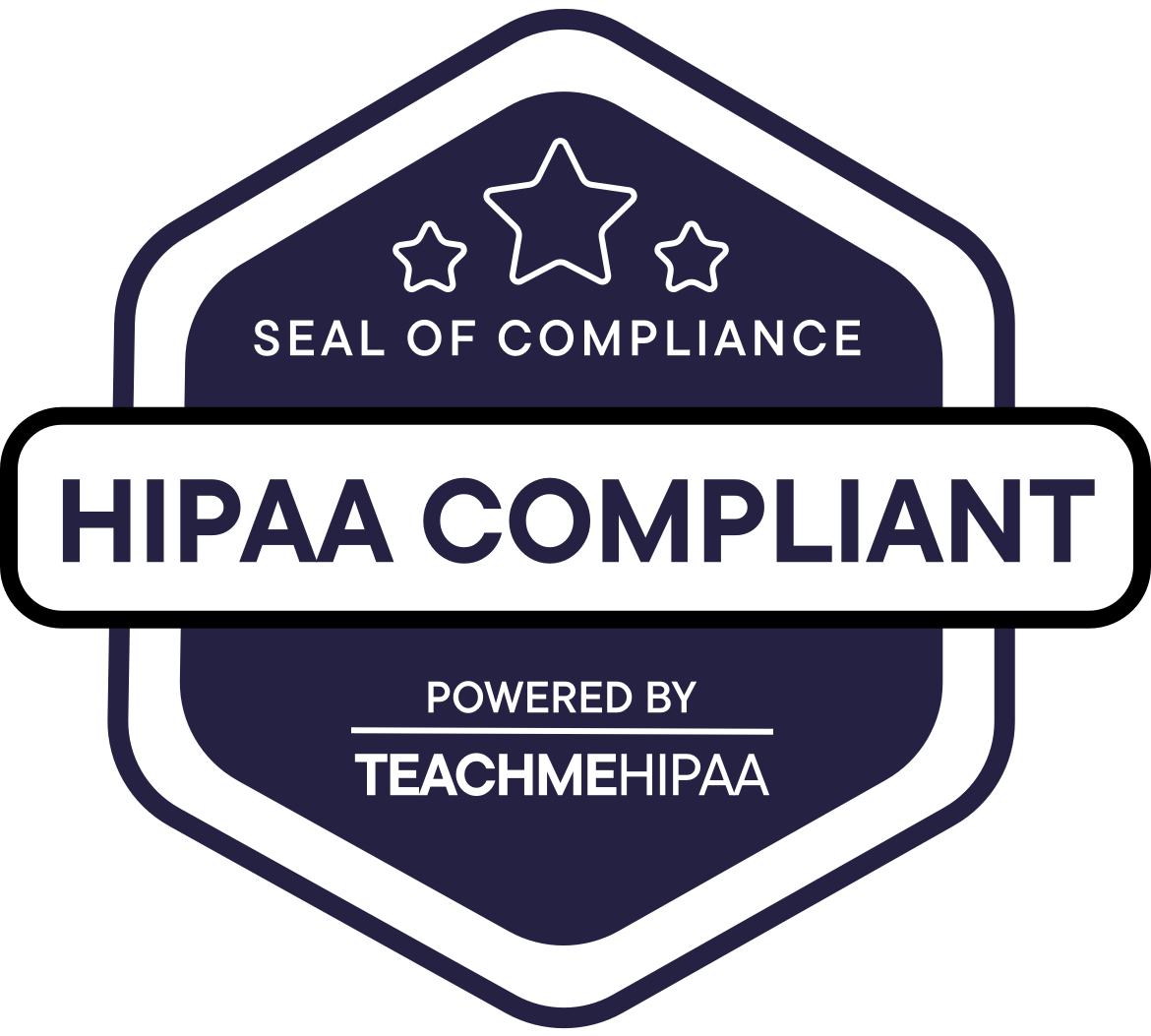

7 Steps: Can You Get a Service Dog for ADHD?
by Lena Park
Last updated: August 11, 2025
Verified and Approved by:
Angela Morris,
MSW, LCSW
Fact Checked

Overview
This article compassionately outlines the steps to determine eligibility and obtain a service dog for individuals with ADHD. It begins by recognizing the emotional struggles that many face, emphasizing the importance of having a formal diagnosis and documentation from a licensed mental health professional. Understanding these needs is crucial.
The article further details the legal rights under the ADA, which can be a source of reassurance. It highlights the necessity of identifying specific tasks that the service dog will perform, fostering a sense of purpose and support.
Furthermore, it underscores the significance of proper training and ongoing support, which can greatly enhance the handler’s daily functioning and emotional well-being. This nurturing approach aims to empower individuals, reminding them that they are not alone on this journey.
Introduction
Navigating the complexities of attention deficit hyperactivity disorder (ADHD) can feel overwhelming, often accompanied by challenges that disrupt daily life and overall well-being. Many individuals find themselves yearning for a source of support, and for some, the prospect of a service dog emerges as a beacon of hope. This companionship not only offers comfort but also provides practical assistance tailored to their unique needs.
Yet, the journey toward securing a service dog for ADHD can raise important questions:
- What are the eligibility requirements?
- What documentation is necessary?
- How can one ensure that the chosen service dog provider meets the right standards?
This article seeks to gently guide readers through the essential steps and considerations, helping them explore whether a service dog could be the transformative support they are seeking.
Assess Your Eligibility for an ADHD Service Dog
Begin by consulting with a licensed mental health professional to obtain a formal attention deficit hyperactivity disorder diagnosis. This step is crucial, as a professional evaluation will provide the necessary documentation to support your case when asking, can you get a service dog for ADHD.
Evaluate the severity of your attention deficit hyperactivity disorder symptoms and their effect on your everyday life. Many individuals facing attention deficit hyperactivity disorder experience significant challenges in daily functioning, impacting both work and personal relationships. As mental health experts note, “Attention Deficit Hyperactivity Disorder can significantly affect a person’s capacity to sustain concentration and handle everyday activities, rendering the assistance of a support dog crucial.”
Consider whether your symptoms are severe enough to ask yourself, can you get a service dog for ADHD?. For those whose attention deficit hyperactivity disorder symptoms significantly interfere with their ability to manage daily tasks, one might wonder, can you get a service dog for ADHD?. Mental health specialists emphasize that, ‘For some individuals, the support of an assistance dog can be transformative, aiding them in navigating the complexities of everyday life.’
Familiarize yourself with regional laws and guidelines concerning assistance animals and attention deficit hyperactivity disorder. Understanding your rights under the Americans with Disabilities Act (ADA) is essential for advocating for your needs. Assistance dog owners enjoy full public access rights, allowing them to bring their assistance dogs into public spaces, including restaurants and public transportation. Moreover, they are entitled to housing accommodations, even in areas where pets are typically restricted. Many adults with ADHD encounter challenges in accessing medication and treatment, highlighting the importance of knowing your rights and options.
If you plan to travel with your psychiatric assistance dog, it’s important to contact the Air Canada Medical Assistance Desk at least 48 hours before your flight. Inform them that you have an assistance dog and inquire about additional floor space if needed. This proactive approach ensures a smoother travel experience for both you and your assistance dog.
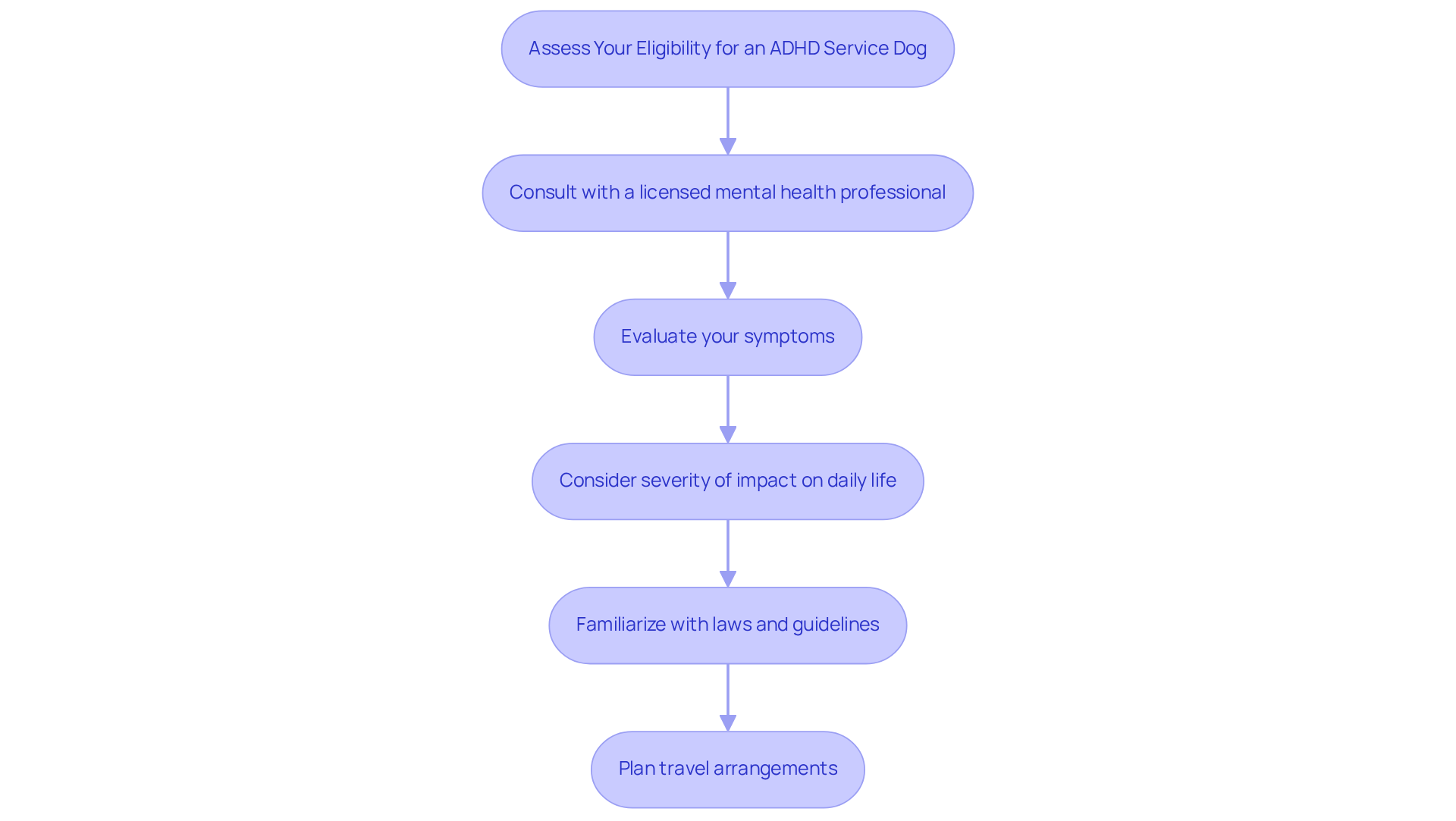
Gather Required Documentation and Medical Support
To begin your journey towards obtaining an assistance dog, it’s essential to secure a letter from your healthcare provider. This letter should verify your diagnosis of attention deficit hyperactivity disorder (ADHD) and explain how you can get a service dog for ADHD to support you in your life. This document will serve as a vital foundation for your application, providing the necessary validation of your needs.
As you gather your documentation, consider including relevant medical records that detail your ADHD treatment history. These records can showcase the ongoing management of your condition, which raises the question of whether you can get a service dog for ADHD to support you. Remember, the more comprehensive your documentation, the stronger your application will be.
It’s important to ensure that all your documentation is current and accurately reflects your mental health status. Outdated or incorrect information can create obstacles in your application process, which can be frustrating. Keeping your records up-to-date is crucial for a smoother experience.
Additionally, maintain copies of all documents for your own records and future reference. Having organized documentation not only helps in your interactions with assistance dog organizations but also prepares you for any discussions with landlords regarding your rights under the Fair Housing Act and Air Carrier Access Act. This proactive approach can empower you to advocate effectively for your needs and ensure you receive the support you deserve.
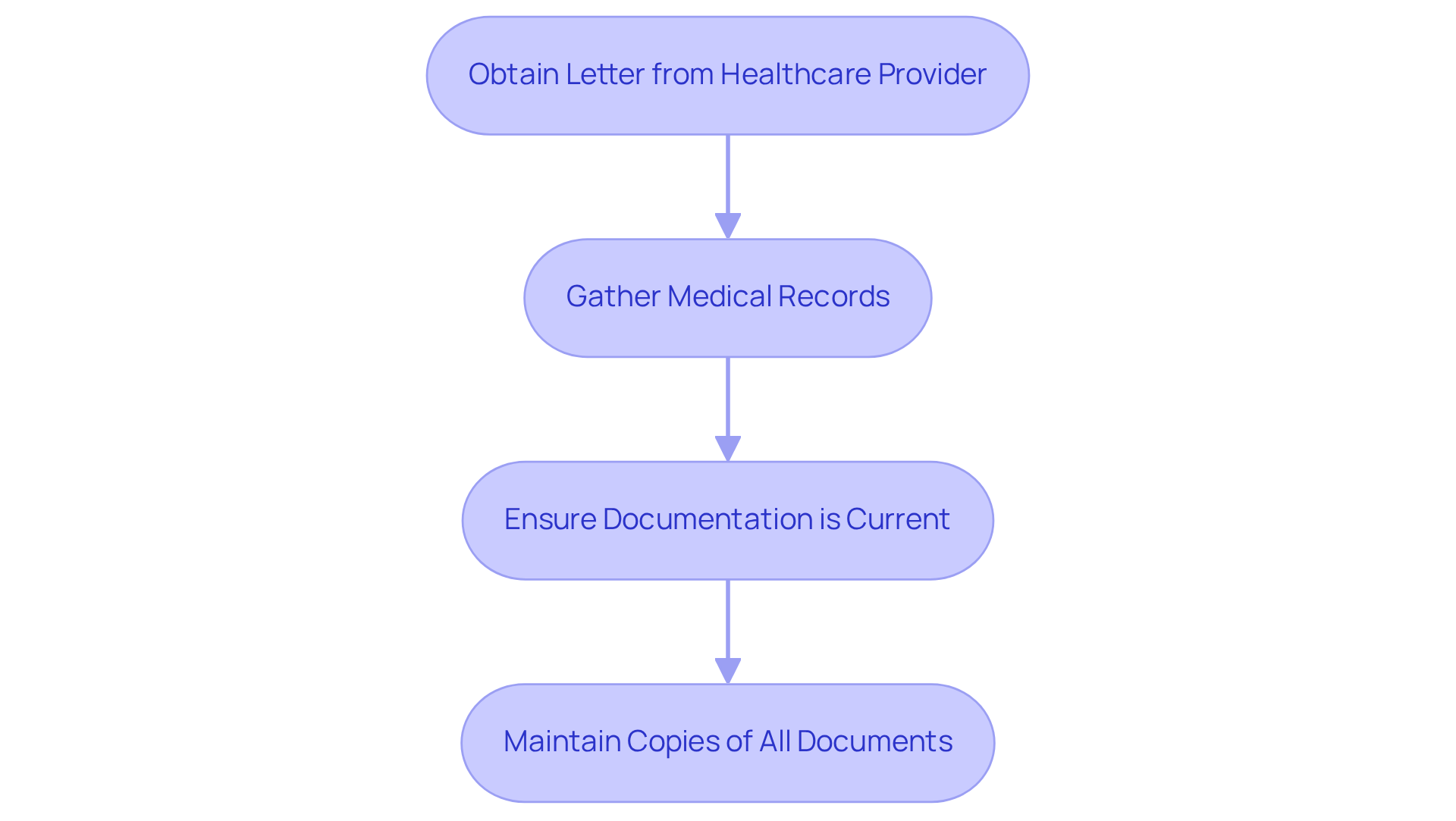
Identify Tasks and Training Needs for Your Service Dog
Recognizing the specific tasks your assistance dog will perform is essential for maximizing their effectiveness in supporting your mental health. For individuals with ADHD, a common question is, can you get a service dog for ADHD to perform tasks such as:
- Alerting you when you become distracted, helping to refocus your attention
- Reminding you to take medication, ensuring adherence to your treatment plan
- Providing deep pressure therapy during anxiety episodes, which can help ground you and alleviate stress
When considering an assistance animal, it’s crucial to explore training programs that focus on psychiatric support animals. These programs often emphasize teaching canines to perform tasks tailored to the specific needs of their handlers, fostering a deeper bond and understanding.
Deciding whether to train the dog yourself or seek professional assistance is another important consideration. Professional trainers possess the knowledge required to prepare your assistance dog for the demands of their role effectively. Statistics indicate that many individuals wonder if they can get a service dog for ADHD, as assistance animals significantly enhance their quality of life, with 70% of participants reporting increased independence in daily activities. This underscores the importance of proper training and the positive impact these animals can have on mental health outcomes.
It’s also vital to understand that psychiatric assistance animals share the same rights as conventional support animals, including access to public places and no-pets housing. Knowing these rights can provide peace of mind as you navigate your journey with your assistance dog, ensuring that you feel supported every step of the way.
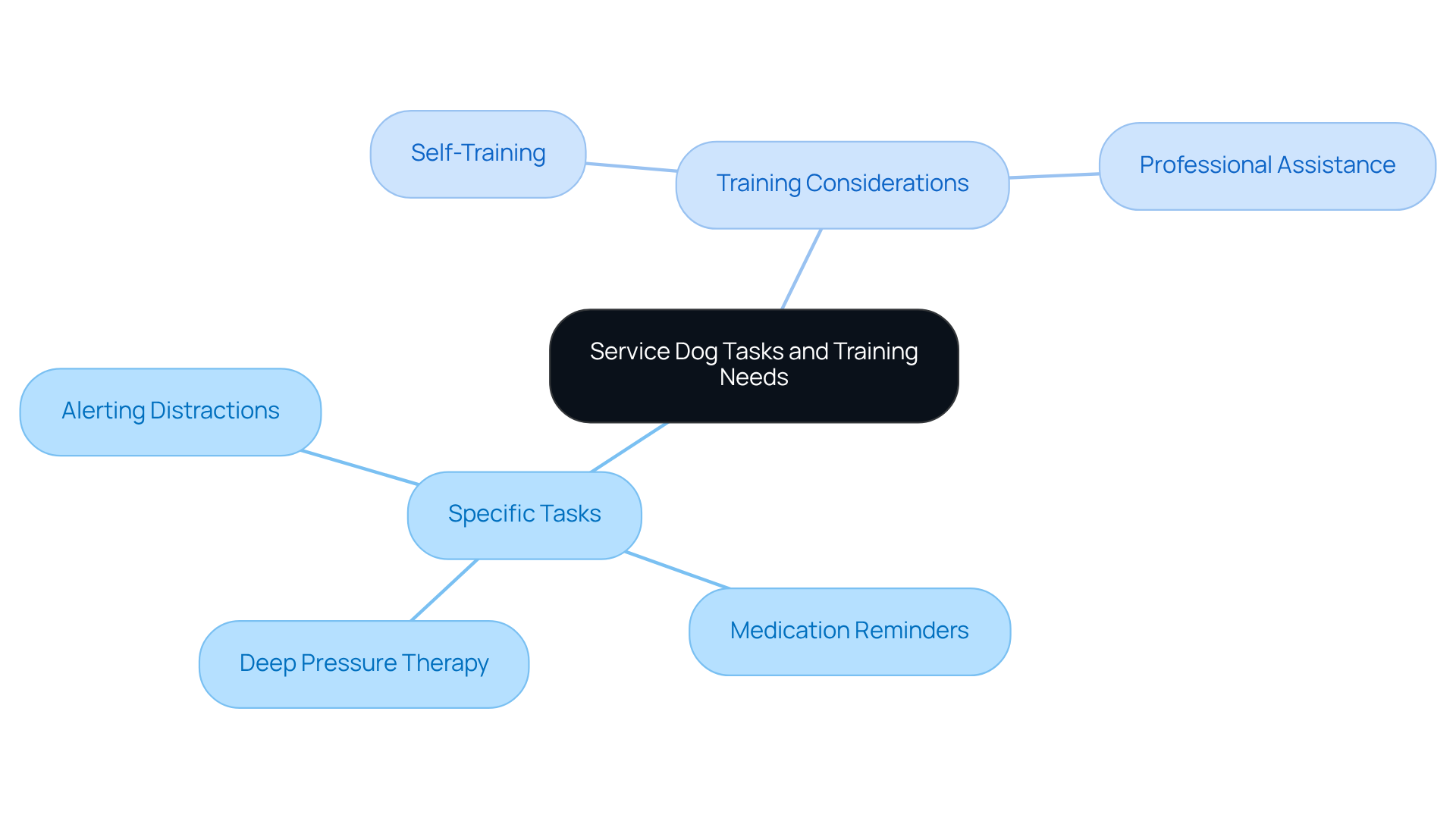
Research and Select a Certified Service Dog Provider
When seeking assistance animals, it’s important to look for organizations accredited by Assistance Dogs International (ADI) or similar reputable bodies. These organizations uphold high training and ethical standards, which is vital for ensuring the best outcomes. Notably, 55.39% of assistance canines are trained by these recognized organizations, underscoring their trustworthiness.
Reading reviews and testimonials from past clients can provide valuable insights into the provider’s reputation and the effectiveness of their assistance animals. Positive feedback often indicates a successful pairing between clients and their assistance animals, which is crucial, especially considering that fewer than 1% of people with disabilities in the U.S. are partnered with assistance animals.
It’s also essential to inquire about the training methods utilized by the organization. Understanding the types of tasks the dogs are trained to perform, which can vary based on individual needs, is key to ensuring the dog will meet your specific requirements. This knowledge can alleviate concerns and foster confidence in your decision.
Scheduling consultations with potential providers allows you to discuss your unique needs and expectations. This interaction not only helps you assess the provider’s responsiveness but also their willingness to customize their offerings to suit your situation. Furthermore, being paired with a support dog can lead to significant financial advantages, such as reduced medication and care hours, making this investment truly worthwhile.
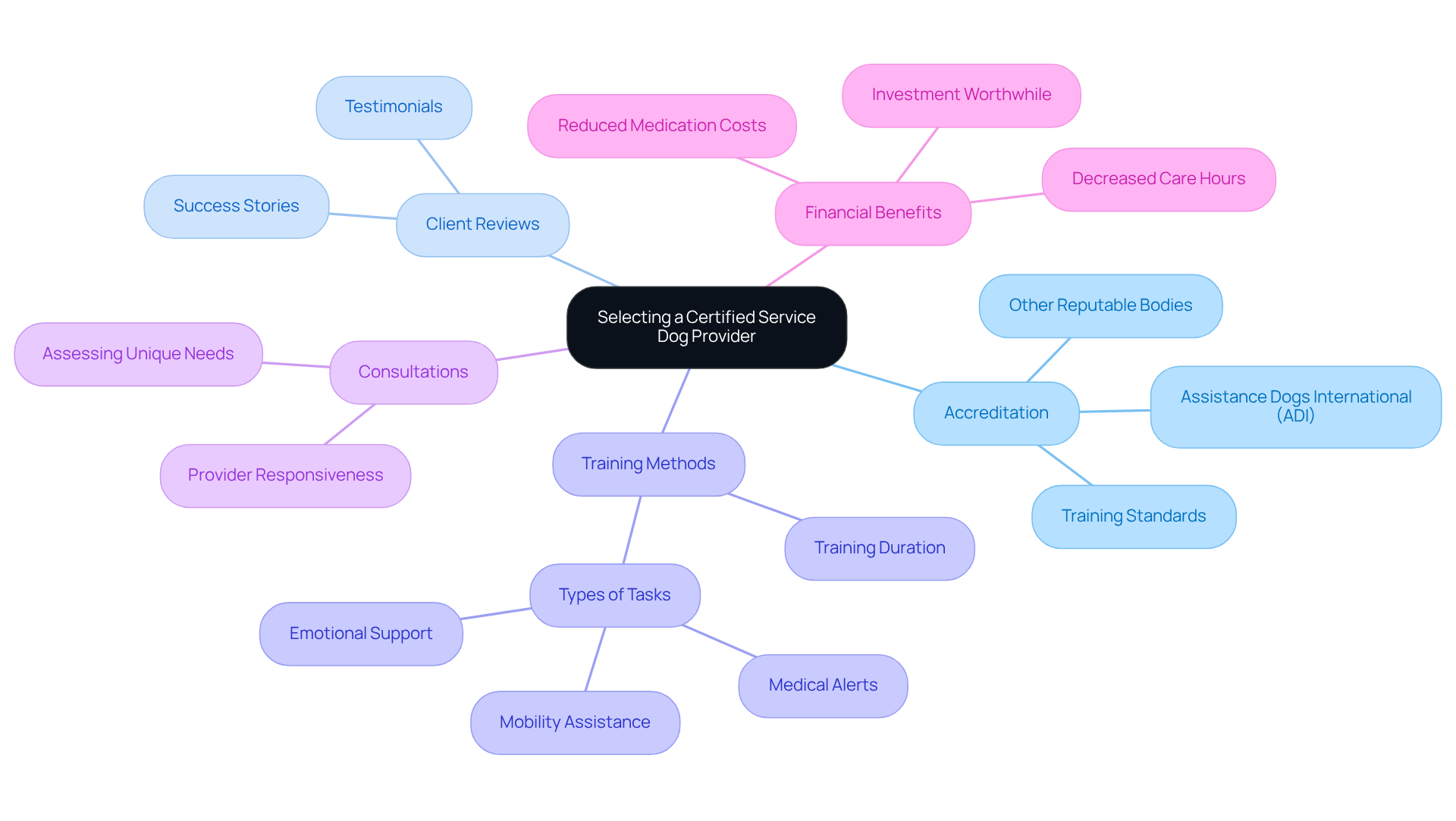
Understand the Legal Rights and Responsibilities
Acquaint yourself with the Americans with Disabilities Act (ADA), which compassionately mandates that assistance animals must be welcomed in all areas accessible to the public. This includes eateries, medical facilities, and public transit, ensuring that individuals with disabilities can access vital resources without barriers.
It’s important to understand the key differences in legal rights between assistance animals and emotional support animals (ESAs). Service animals are specially trained to perform tasks that assist individuals with disabilities, such as guiding those with visual impairments or alerting those who are deaf to important sounds. In contrast, ESAs offer comfort but do not enjoy the same legal protections under the ADA. Notably, only dogs are recognized as assistance animals under titles II and III of the ADA, making this distinction crucial for navigating public spaces and housing situations.
As a handler of an assistance dog, you hold the important responsibility of maintaining control over your dog at all times. This includes using a harness, leash, or tether unless your disability prevents you from doing so. Proper control not only ensures safety but also aligns with ADA regulations, promoting a sense of security for everyone involved.
Be prepared to educate others about your rights. If you find yourself questioned about your assistance dog, remember that staff can only ask two specific questions:
- Whether the dog is needed due to a disability
- What tasks the dog has been trained to perform
Being familiar with these rights can ease misunderstandings and foster awareness. Remarkably, 97.1% of assistance dog owners are aware of the Americans with Disabilities Act (ADA), reflecting a strong understanding of their rights and the support available to them.
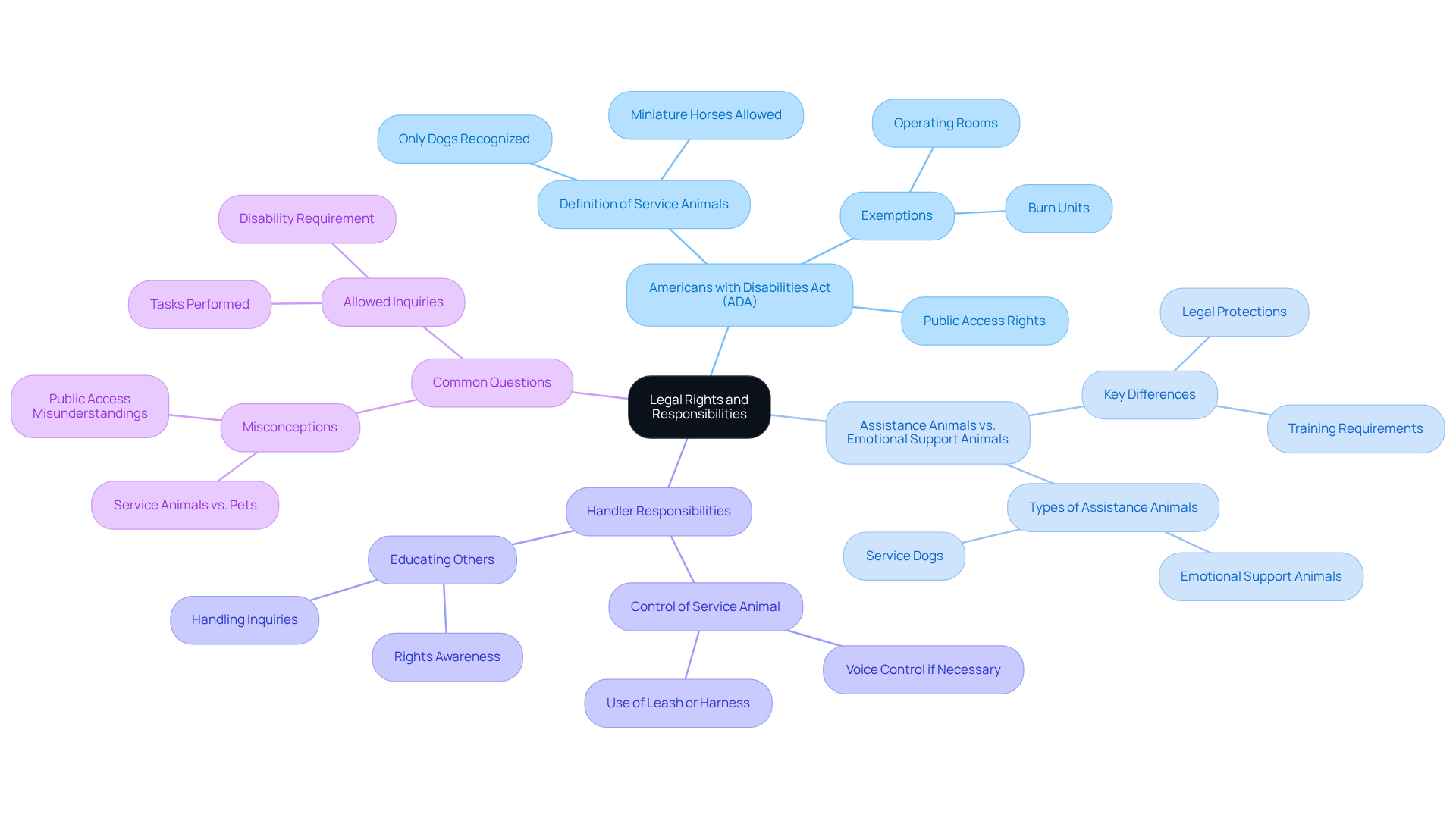
Prepare for the Transition and Integration
- Create a safe and comfortable environment for your assistance dog at home, ensuring they have a designated space to relax and feel secure. This is crucial for their well-being and effectiveness in assisting you. How might your dog feel in their own cozy corner, away from distractions?
- Establish a daily routine that smoothly integrates your assistance dog’s tasks. This not only helps the dog understand their role but also reinforces your bond and enhances their training. Consider how a predictable schedule can bring peace to both you and your furry friend.
- Inform family members or housemates about the assistance dog’s duties and the most effective ways to engage with them. Clear communication fosters a supportive atmosphere for both the dog and the household. Have you shared the importance of this role with those around you?
- Exercise patience during the adjustment period, which typically lasts several weeks. Research shows that the typical acclimatization phase for assistance animals can vary from 2 to 6 weeks, depending on the specific animal and handler. Both you and your assistance dog will need time to adjust to each other’s habits and signals, making this phase vital for establishing a strong partnership. Remember, this journey is about growth for both of you.
- Based on a longitudinal study, it has been reported that successful transitions with assistance dogs for ADHD raise the question of how can you get a service dog for ADHD to significantly enhance the handler’s daily functioning and emotional well-being. Incorporating insights from experienced trainers can also provide valuable strategies for a smoother integration process. Reflect on how these insights could transform your experience together.
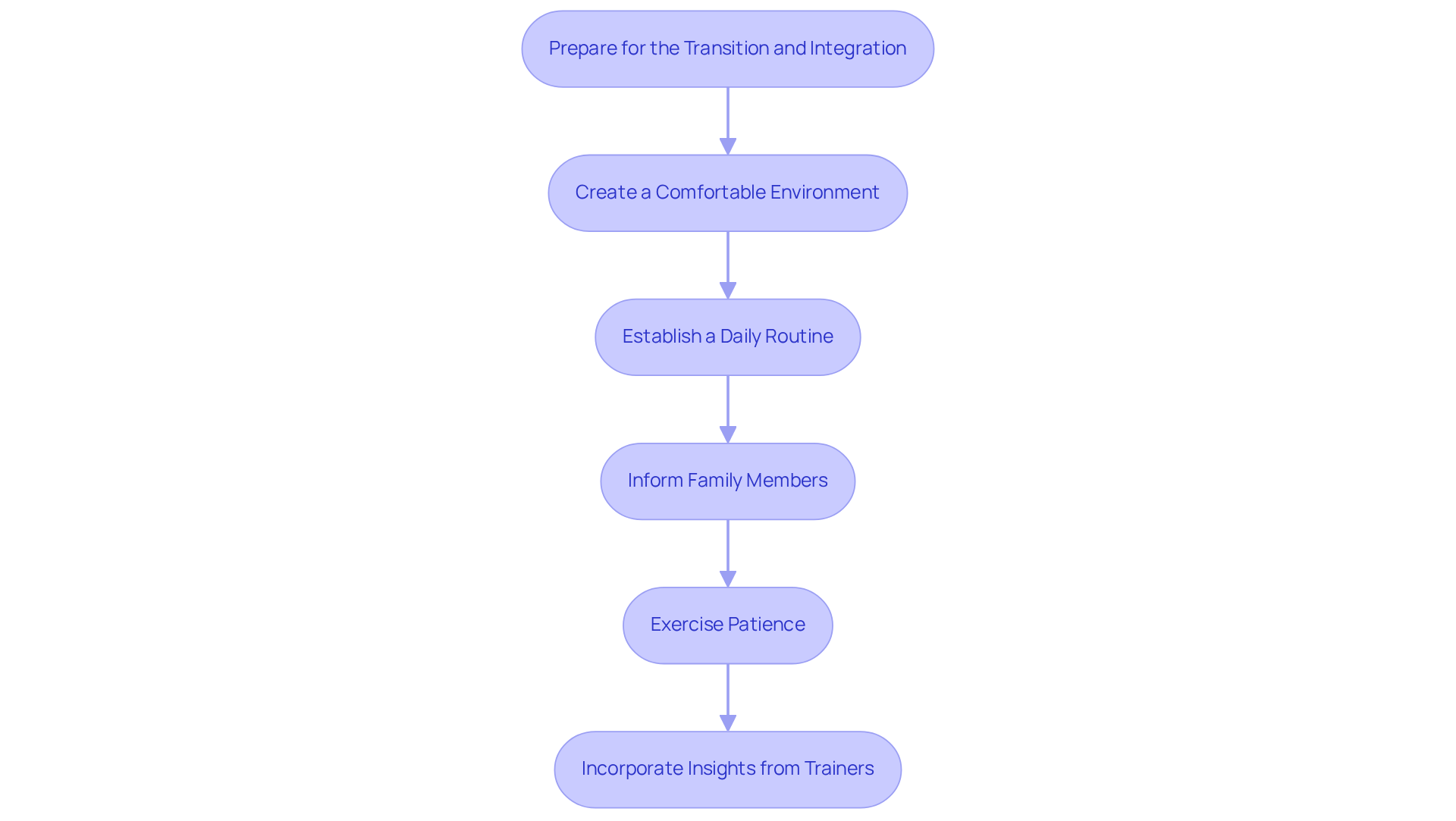
Maintain Ongoing Training and Support
Consider arranging frequent training sessions to strengthen the commands and tasks your assistance dog needs to master, ensuring they remain well-prepared to help you effectively. It’s important to seek assistance from trainers or specialized support groups for assistance dog handlers; these resources can provide valuable insights and shared experiences that enrich your journey.
Observe your assistance dog’s behavior closely, addressing any issues promptly to nurture a strong working relationship. Continue to educate yourself about ADHD and the question of how can you get a service dog for ADHD; this knowledge will enhance your partnership and improve the overall effectiveness of your assistance dog.
Remember that training an assistance dog can take between 1 to 2 years, with dropout rates for candidates ranging from 50-70%. This highlights the necessity for continuous support along the way. Additionally, be aware that the cost of training a service dog can exceed $25,000, making it crucial to seek out resources and support groups that can help you navigate this journey.
As Gene Hill wisely noted, “Nobody can fully understand the meaning of love unless he’s owned a dog.” This quote beautifully captures the deep bond that can develop through training and support, reminding us of the emotional connection that enriches our lives.
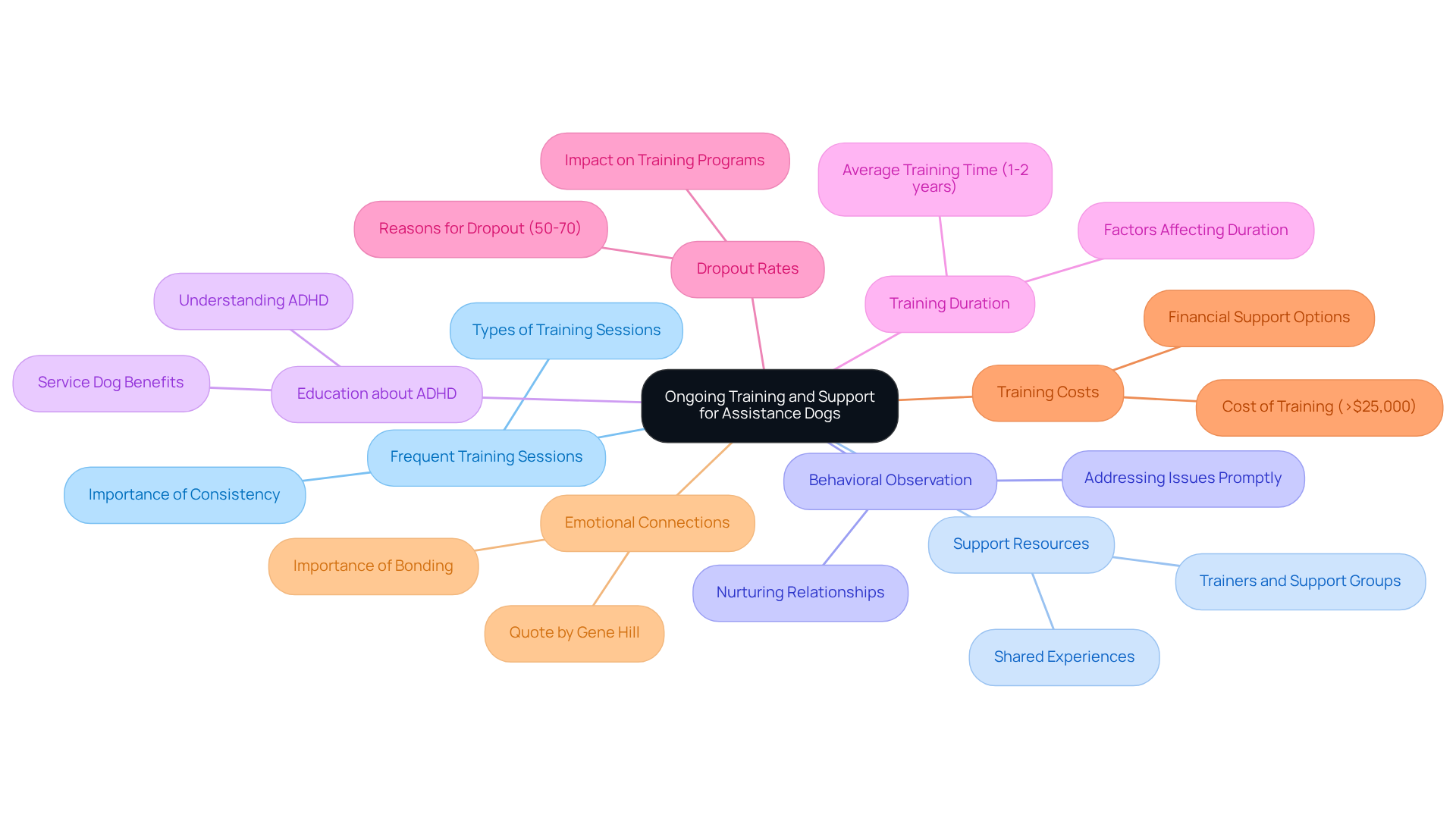
Conclusion
Understanding whether a service dog can assist individuals with ADHD requires a compassionate approach that considers eligibility, documentation, and training needs. This article highlights essential steps, underlining the importance of consulting mental health professionals and gathering the necessary medical support to affirm the need for a service dog. By acknowledging the potential benefits and legal rights linked to assistance animals, individuals can navigate the process of obtaining a service dog tailored to their unique circumstances.
Key insights include:
- The vital role of proper documentation.
- The understanding of the specific tasks that service dogs can perform for those with ADHD.
- The significance of choosing a certified service dog provider.
- The ongoing commitment to training and support, ensuring that both the handler and the assistance dog can flourish together.
- The integration process, along with the handler’s responsibilities, is essential for nurturing a successful partnership.
Ultimately, the journey to acquiring a service dog for ADHD transcends merely obtaining an animal; it is about enhancing quality of life and improving daily functioning. For individuals considering this path, taking proactive steps in research and advocacy is vital. Engaging with professionals and support networks can profoundly affect the effectiveness of the assistance dog, paving the way for a more fulfilling and manageable life. Embracing this journey can lead to transformative changes, making the question of “can you get a service dog for ADHD?” not just a possibility, but a pathway to empowerment and independence.
Frequently Asked Questions
What is the first step to assess eligibility for an ADHD service dog?
The first step is to consult with a licensed mental health professional to obtain a formal ADHD diagnosis, as this documentation is necessary to support your case for a service dog.
How do ADHD symptoms affect daily life?
Many individuals with ADHD experience significant challenges in daily functioning, impacting both work and personal relationships, which may necessitate the assistance of a support dog.
How can a service dog help individuals with ADHD?
For some individuals, the support of an assistance dog can be transformative, aiding them in navigating the complexities of everyday life and managing daily tasks.
What should I know about laws regarding assistance animals and ADHD?
It’s important to familiarize yourself with regional laws and guidelines concerning assistance animals. Under the Americans with Disabilities Act (ADA), assistance dog owners have full public access rights and are entitled to housing accommodations.
What should I do if I plan to travel with my psychiatric assistance dog?
Contact the Air Canada Medical Assistance Desk at least 48 hours before your flight to inform them about your assistance dog and inquire about any additional floor space needed for a smoother travel experience.
What documentation is required to obtain an assistance dog?
You need a letter from your healthcare provider verifying your ADHD diagnosis and explaining how a service dog can support you. Including relevant medical records detailing your treatment history can strengthen your application.
Why is it important to keep documentation current?
Ensuring that your documentation is current and accurately reflects your mental health status is crucial, as outdated or incorrect information can create obstacles in your application process.
How can I prepare my documentation for future reference?
Maintain copies of all documents for your records and future reference. This organization helps in interactions with assistance dog organizations and discussions with landlords regarding your rights under the Fair Housing Act and Air Carrier Access Act.
Certify Your Emotional Support Animal Today

Why You Can Rely on Us?
At Wellness Wag, we believe your pet deserves care rooted in both science and compassion. Each article is carefully researched, written in clear language for pet owners, and then reviewed by qualified professionals to ensure the information is evidence-based, current, and practical for real-life care. Our goal is to help you feel confident in making informed decisions about your pet’s health and well-being.
Reviewed by
Angela Morris, MSW, LCSW
Angela is a licensed clinical social worker with 20 years of experience in patient advocacy and community mental health. She has assisted numerous clients with ESA evaluations and brings a deep understanding of disability accommodations, ensuring that all information is accurate, supportive, and practical.

Written by :
Lena Park
Last Updated :
August 11, 2025












